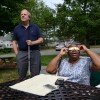COVID-19 has upended the way we live and brought catastrophic destruction to the ecosystems that connect us. Summer concerts, festivals, parades, and sporting activities have been cancelled. Students have been out of school since March and there is no guarantee they will return to the classroom in September. Racial disparities in coronavirus infection rates have further exposed longstanding societal inequities now fueling a nationwide resurgence of the Black Lives Matter movement.
This is a crisis we cannot afford to waste.
As arts educators who have witnessed the life-changing power of art and culture, we know that money invested in arts education contributes to improved academic outcomes, increased civic engagement, and enhancedracial equity. Students who have consistent access to arts instruction show greater empathy and compassion for others. With its ability to engage and inspire minds of all ages, educate joyfully, and give expression to our emotions, arts education is one of the tools we need now to build a better world.
That is why we strongly urge state lawmakers to fully fund the Student Opportunity Act passed late last year and protect Chapter 70B funding, which distributes aid to school districts across the state. We also urge municipalities to resist cuts to education, which inevitably lead to reducing or eliminating arts instruction altogether. Now more than ever, we must spend our political capital to enact budgets that invest in proven solutions, even if it means allocating funds from other areas such as public safety to do so.
There are compelling examples throughout the Commonwealth showing the power of arts education to improve the learning and well-being of students and, by extension, the safety of their communities. Here are two.
In 2012, after years of poor performance, the state took the Lawrence public schools into receivership to direct the district’s efforts to improve its schools. Jeff Riley, now Commissioner of the Department of Elementary and Secondary Education, was appointed Receiver-Superintendent. Riley included “development of arts opportunities across all grades in the district” with “new programs in choral and instrumental music, musical theater, and visual arts” as essential ways to meet the turnaround plan’s primary objective: to engage students more fully in school.
Focusing on the arts was something Riley learned when he was principal of Edwards Middle School in Boston. There, he used an extended school day to offer classes in dance and visual arts which made the extra time in school something students looked forward to as part of their educational experience. Today, graduation rates in Lawrence public schools continue to increase along with MCAS test results.
In 2003, Roxbury’s Orchard Gardens K-8 School was one of the lowest-performing schools in the state. In 2009, the school hired a new principal who understood the power of the arts to keep students engaged and parents involved in the school through student exhibitions and performances. In short order, the principal defunded the line item for security guards and invested those funds in hiring arts instructors. It didn’t take long before teachers, parents, and students themselves noticed a difference. On account of its success, President Obama’s Committee on the Arts and Humanities named Orchard Gardens one of eight pilot Turnaround Arts Initiative schools in the country in 2012.
Imagine what could be accomplished if the city of Boston and any of the 26 Massachusetts Gateway Cities reinvested the millions of dollars now spent policing schools—often with questionable results—in arts instruction! As multiple crises swirl around us, we have a once-in-a-generation opportunity to question the way we do business and fundamentally reshape the world as we know it. This is a call we cannot ignore. Now is the time for radical reimagination and transformation — something the arts do best.
Barbara Wallace Grossman, PhD, is a professor of theatre at Tufts University. Jonathan C. Rappaport is the executive director emeritus of Arts|Learning. Both are members of the MASSCreative Board of Directors.




